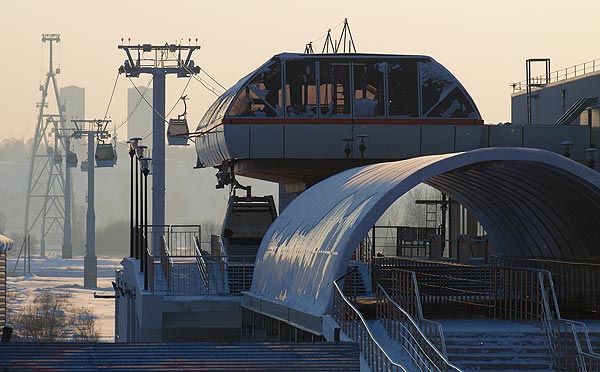Last month ropeway manufacturer Poma officially completed an urban gondola lift crossing the Volga river in Russia. We first mentioned the Nizhny Novgorod gondola last year and while the completion was a little bit behind schedule, we’re certainly happy to see it finished and in operation.
From the specs available, it’s a curious system. Both impressive in some ways and utterly bland in others.
The system is built on a standard off-the-shelf MDG configuration and operates at a standard 5 m/s or 18 km/hr. It currently offers a limited capacity of only 500 pphpd but is to be expanded to 1,000 pphpd later this year. While only having two stations, those stations are integrated into the public transportation network – and those stations are separated by 3,660 meters! That’s impressive considering the length of other comparable MDG systems.
More impressive is this: Two of the gondola towers reach heights of 82 meters allowing for a 900 m span between those towers. That’s a remarkable feat very uncharacteristic of standard MDG installations. Spans like that are more typical of Funitels or 3S systems. Always nice to see advancement and innovation.
Given the time, distance and cost involved to get a tour of the system, I highly doubt we’ll have any first-hand information anytime soon, but in the meantime, you can checkout ropeways.net to learn a little bit more about the system.
(Interesting side note: Take a look at the image above and the other images available on ropeways.net. Focus on the stations. Now compare those to the images and renderings we published last year. A little bit different, no?)


3 Comments
Could anhybody point me towards a table of some kind that equates the height of towers to the length of span between them,together with the maximum gradient transition that a cable can normally sustain?
Generally you won’t see a gradient above 45 degrees – unless of course you’re talking about an elevator. The height of towers and the length of span are, of course related, but I’m not sure there are any publicly available tables. Probably something that just the engineer corps of the ropeway companies know. I can ask around however – but I’m guessing those are proprietary (or at the very least well-guarded).
I’m assuming Peak 2 Peak is the extreme example. They give lots of stats on their website: http://ww1.whistlerblackcomb.com/p2pg/details/